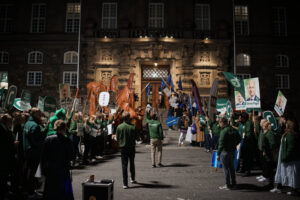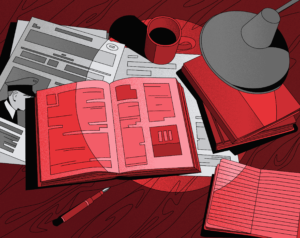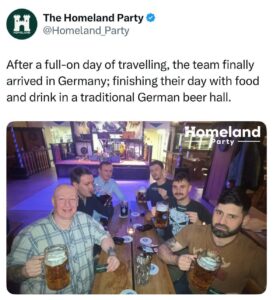This article is part 2 of 7 in the Hammerskins Series. This series was originally published in German via Exif – Recherche & Analyse, and gives us an in-depth look into one of the oldest and most stable neo-Nazi organisations worldwide. This second part of the series explains the identity of Hammerskins and its members, their rules and codes, as well as symbols and visuals they deploy.
Part 1 draws a larger picture of the network, its history, and its organisational infrastructure. Part 3 gives a detailed account and explanation of their engagement in criminal activities, such as murder and terror attacks. All their activities are funded via multiple streams of revenue, which Part 4 analyses. Part 5 sheds light on the role of Hammerskins in the ‘NSU Complex’. Part 6 delves into the transnational aspect of the organisation and associated problems they face because of it. The final part of the series, Part 7, focuses on the failure of German intelligence services to identify Hammerskins as an influential actor within right-wing extremism in Germany and worldwide. One central goal of this series is to drag Hammerskins workings out of the shadows and give possibility to the developing of counter-strategies, which so far seemingly has not happened.
On the British band Pink Floyd’s 1979 concept album The Wall, the singer, who is obviously high on drugs, exclaims: ‘That one looks Jewish! And that one’s a coon! Who let all of this riff-raff into the room? There’s one smoking a joint, And another with spots! If I had my way, I’d have all of you shot!’ A film of the same name provided the images to accompany the album in 1982.
The quoted lines are used in a sequence in which the main protagonist Pink is high on meds. Suffering from depression, the rock star and anti-hero isolates himself from society. Completely stoned, he hallucinates that he walking out on stage as a fascist leader in front of a huge crowd, inciting hatred and violence among the masses. Around him hang draped various flags displaying two crossed carpenter’s hammers.
Pink’s followers, with their heads shaven, ensure security at the venue wearing the hammers on their bomber jackets and immediately lunge at the groups Pink has named. In addition to the raised extended arm—the Nazi salute—Pink also uses a salute of his own. With his fists clenched he crosses his arms in front of his chest. This is meant to resemble the crossed hammers.
Pink’s Concert with its references to the aesthetics and function of fascist mass movements is quite intentional on the part of the producers. Following the protagonist’s hate-inciting speech, the film shows scenes of fascist thugs brutally attacking black people for several minutes on end. A parade of men in black uniforms turns into a sea of hammers marching in lock-step. The scene symbolises Pink’s descent into madness.
Pink Floyd is not a band known to sympathise with fascist ideology. Rather, the violence and fascist aesthetics are meant to illustrate the protagonist’s madness. Nevertheless, there is room for interpretation for neo-Nazis. Neo-Nazis celebrate the violence shown, they re-define terms and positively charge the narrative.
The Hammerskins adopted the symbols of the anti-heroes of the The Wall album—both the crossed hammers and the Crossed-Hammers salute. ‘Hammering our way towards victory’, an HSN slogan, is the call to take power by force. In The Wall, the hammers smash doors, forcing people to run for their lives. The HSN’s point of reference has nothing to do with the film’s actual intention, but the violence committed by Pink’s followers.
In the late 1980s, right-wing skinhead gangs did actually attack people in similarly brutal ways on US streets. Hammerskins wanted to stand out as an elite and present themselves as a “purifying” force. In their imagery, they reproduce their self-understanding as a superior collective, as a soldierly, hyper-masculine formation. ‘We are healthy people in a sick world’, Forrest Hyde describes the role of the Hammerskins, and further elaborates: ‘(…) We are a league, a brotherhood and a nation within the nation (…) In fact, what we absolutely have in common is what is important and that is the establishment of a higher standard, higher values and morals (…) the desire to become the superior human being or übermensch. (…)’ Hyde co-founded the Hammerskins in the US and wrote these lines in a rather incendiary letter in 1999, addressing his “brothers” all over the world in the sultry pathos of the multi-page text.
Hammerskins around the world refer to Hyde’s “teachings” with almost religious zeal. To this day, Hammerskins’ self-descriptions rely heavily on terms such as honour, loyalty, courage, integrity and, above all, the elite. There is no other organisation that values these attributes so highly and places such great importance on its reputation and selective recruitment of new members. The resulting habitus is as cold and distant as it is appealing.
Other extreme right-wing organisations today also require potential new members to complete a probationary period, but the Hammerskins are probably unique in their pretensions. Their high standards distinguish them from other groups, and they lay claim to a leadership position.
In the HSN founding years, younger neo-Nazi skinheads in particular were the main target group, and the Hammerskins’ recruitment strategy was to present themselves as role models and promote such virtues as strength, reliability, unity and brotherhood. Today, the skinhead cult has become far less relevant.
As early as the 1990s, the Hammerskins’ rulebook already anticipated the possibility of a future decline in the importance of skinhead culture. There, it read that although they took being a ‘skinhead very seriously’, they would not allow themselves to be limited by stereotypes; what counted was that ‘[y]ou are honourable’.
The motorcycle club as a blueprint for the brotherhood
In the spring of 2016, the Antifaschistisches Infoblatt analysed the process by which neo-Nazis decide to turn a comrade into a “brother” and the political group (comradeship) gives way to the brotherhood.
The text stated: ‘The identity form of a brotherhood is supposed to represent something greater, something more noble than belonging to an explicitly political group. The brotherhood is a place of longing, charged by the pathos of lifelong membership. It reflects the desire to belong to a group that promises continuity and order, that is exclusive, enduring, familiar, manageable and free of contradictions, and where a masculine cult and elitist posturing can be embraced and celebrated without restrictions. The brotherhood epitomises adulthood and distinction, providing escape and withdrawal into a fully self-sufficient community.
During their decades of existence, Hammerskins, like no other organisation, have shown their capacity to grow a network of “brothers” without losing sight of the “bigger picture” in the process. Their rituals, the ways in which they award insignia and status, their set of rules and habitus do not simply mimic the motorbike clubs (MC), but are in fact their exact replica.
The Hammerskins do not primarily use the power of the images created by MCs simply to spread fear. They never wanted to be a toothless tiger, but rather used the rules of the rocker world in order to facilitate their organisation efforts and wall themselves off. Like MCs, they recognise only their own laws, to which they take their own oaths of allegiance.
‘The brotherhood generally operates in a thoroughly ritualised social space, in which the “old ones” make sure that the young ones don’t mess things up (…)’ the AIB wrote in a 2016 article titled “Right-wing Brothers” (“Rechte Brüder”). The group, in this case the Hammerskins, are an exclusive, male-only society. The group follows a strict procedure in selecting its members, seeking to promote and integrate only whom they deem the very best.
As a community of men, women cannot become “full members”. It is more than obvious that a regressive image of masculinity prevails. With one’s “brothers”, on the other hand, one shares everything, as the brotherhood dominates the social space.
The Hammerskins spend their holidays together (with or without family), go on city trips and regular visits to other branches around the world, organise concerts, camps and submit to a rigid decision-making structure.
Strategy meetings—on a national and international scale—take place every quarter. They create both opportunities and dependencies—as well as an indispensable mutual loyalty among members.
Being a Hammerskin or close to the ‘brotherhood’ entails certain benefits, another feature inspired by motorcycle clubs. Club members boast that they can travel to any country where a chapter of their club exists and will always be welcomed by their fellow members there, even if they do not yet personally know them. Another benefit of the brotherhood is mutual financial and logistical support.
Maintaining a high level of secrecy and loyalty, the Hammerskins have access to chapters around the world that can rapidly come up with considerable funding and serve as a support network for members who have run into trouble with the law.
When the influential Hammerskin Malte Redeker explained the situation in Germany to European Hammerskins a few months after the NSU trio were exposed in 2011 and mentioned that he was also under investigation, he was immediately offered ‘time off’ by several chapters of his brotherhood. He had allegedly been involved in a racially motivated arson attack on a house in which nine people died. ‘We are nearby, south of you, if you need a place where you can feel at home…’, French Hammerskins let him know. Portuguese Hammerskins promised him an ‘open door’ and ‘anything you need’. Very explicitly, the Portuguese also told him: ‘if you need anything to avoid being arrested, call us. We can provide you with whatever is needed, really, everything!’
Rules and codes
Establishing such a structure depends on rules, codes, insignia and a series of terms indicating each member’s status and granting them corresponding authority.
When a person acquires a certain status, this not only serves to bolster that person’s self-esteem and define their degree of authority, but also to demonstrate to members, aspirants and supporters that they are invaluable to the organisation. ‘Federal state representatives can appoint members as (…) or deputies etc. We want everyone to know that he belongs to us!
Activities are necessary to keep everyone’s faith and enthusiasm alive.’ (sic!), says the Hammerskin Constitution of 1998. The document also meticulously outlines who has which duties and obligations, how Hammerskins should behave and what they are expected to commit to.
The Hammerskin Constitution was created by the US Hammerskins and later largely adopted by their European “brothers”. It resembles a legal regime, with each chapter being allowed to add guidelines in order to ensure its implementation in each country. The fact that, within the “nation”, not everybody always acts fully in accordance with the rules is no contradiction.
What seems more important is that a common approach to ‘misconduct’ is sought. The ‘good of the nation’ is repeatedly mentioned like a mantra, including in relation to misconduct by individual members. The question is always whether a certain degree of latitude is beneficial or not. That makes it easier to hold on to long-term members as well as for new aspirants to enter. This applies all the more when probationary periods for candidates appear as merely formal exercises because it is already clear that certain people will eventually reach “full member” status one way or another.
Although the rulebook is supposed to set standards, many examples show that its boundaries are constantly being pushed.
Insignia and symbols
Every “full member” is expected to wear the HSN emblem—the crossed carpenter’s hammers surrounded by a cogwheel—on the left breast area of their bomber jacket. In the case of the HSN, the emblem is highlighted in the German empire’s colours black, white and red. US Hammerskins also wear these colours and thus refer to their European roots and the ‘great fatherland’, i.e. the Third Reich under Adolf Hitler.
Hammerskins sport their chapter patch on the upper left sleeve of their bomber jackets, indicating their exact affiliation much like the cut-off vests used by motorcycle clubs. Further down on the left sleeve there is the “Hammer-Skinheads” cuff title, which is modelled on German SS cuff titles. New members generally only get their cuff title after three years of full membership.
Apart from the bomber jacket, which members are apparently expected to wear in particular at concerts such as the ‘Hammerfest’, dozens of other articles may help identify a Hammerskin. A diverse set of badges, symbols, and codes not only contribute to the mystification of the brotherhood but, above all, serve to distinguish members from the outside world and bolster their internal status.
Each member of the network—whether as a supporter, Crew 38 member, hangaround, prospect of the nation/PotN (aspirant) or “full member”—displays their status by wearing a particular badge. To what extent a member is permitted to use what kind of symbols, salutes and signs is strictly regulated according to status.
The number “38” is a numerical code representing the third and eighth letter of the alphabet—the C and the H, i.e. Crossed Hammers—is used by anyone, men and women, within the network.
Merchandise items that feature the number 38 are freely available as “supporter” gear and can be interpreted as an expression of solidarity with the cause. Emblems showing the cogwheel, the “38” and the term “Crew” are taboo for outsiders. The same applies to merchandise reserved for PotN.
Within the brotherhood, merchandise of the same status level may be exchanged, e.g. a Brazilian PotN can wear “Crew 38 Rheinland” emblems. Emblems with the crossed hammers, the term “Hammerskins/HSN” and the slogan “Hammerskins forever–forever Hammerskins” (HFFH)—as well as its numerical code 8668—are reserved for “full members”. The “Crossed-Hammers” salute is also the exclusive privilege of “full members”.
The HSN goes to great lengths in order to maintain its position as the elite organisation in the scene. Anyone who uses or ‘defiles’ insignia, codes and clothing without authorisation is to be punished. This also includes ex-members who continue to use the symbols even after leaving or having been kicked out.
One such case is that of the musician Andreas Lohei, called “Lolli”, who was a member of the Bremen chapter until the mid-2000s. In 2012, several years after leaving the HSN in “good standing”, he released a CD (with his band “Endlöser”) which not only included the song 38, but also showed Lohei wearing HSN emblems. A discussion ensued and eventually, the conflict grew so intense that the Bremen chapter decided to send a delegation to one of Lohei’s party events.
According to the rulebook from the early 2000s, “full members” are also expected to get a Hammerskin tattoo. After all, identity-enhancing clothing can always be stripped off. The Swiss chapter argued that tattoos would also deter informers.
Dutch Hammerskins explained: ‘Anyone who wants to belong to an elite organisation should understand that they will lose certain freedoms. It is all for the benefit of the group. A holistic identity is just as important as a holistic structure. We believe that even a naked Hammerskin should be recognisable.’
The majority of members have tattoos that display the emblems of the brotherhood. As long as they leave in “good standing”, they are allowed to keep them even after their departure. However, according to the rulebook, these tattoos then have to be amended with an entry and exit date, although this rule is rarely enforced in reality.
During the early years of the HSN in the US, the Arizona Hammerskins were significantly stricter. Along with other members, James Miller removed Sean Cooper’s Crossed Hammers tattoo with a knife.
Sean Cooper, also known as “Warbaby”, had recently left the group. Literally cutting out the tattoo was meant as a warning to him not to challenge the dominance of the Hammerskins, for example by founding a new skinhead group.
In an internal memo, the Italian chapter describes how meticulously they collect the insignia of their former members after a bad-out. Losing control over what former members do—potentially dressed in Hammerskin merchandise—would send a fatal signal.
The uniformity of the brotherhood means they are vulnerable to prosecution by law enforcement. You will ‘never meet a Hammerskin in HS clothing at political events’, Malte Redeker once said to a potential member. In its current self-presentation, the HSN even writes that ‘the political activities and publications of individual members should never occur in the name of the brotherhood’, because the ‘brotherhood does not pursue political goals’.
In Germany, the chapters’ main concern is to conceal affiliations and status, because such information could be used to pursue a ban of the group. The appearance, structure and decision-making processes of Hammerskin groups are similar to those of any given registered society, which, by all means, can be banned; and Hammerskin groups certainly meet all the required legal conditions necessary for a ban.
In the minutes of a meeting of the Saxony Hammerskin chapter at the end of the 1990s, the order is clear: ‘Tear off patches etc. if arrested. Don’t show the HAMMERS in any political activities!’
Apparently, such measures were often sufficient to disappear from the view of law enforcement authorities.







